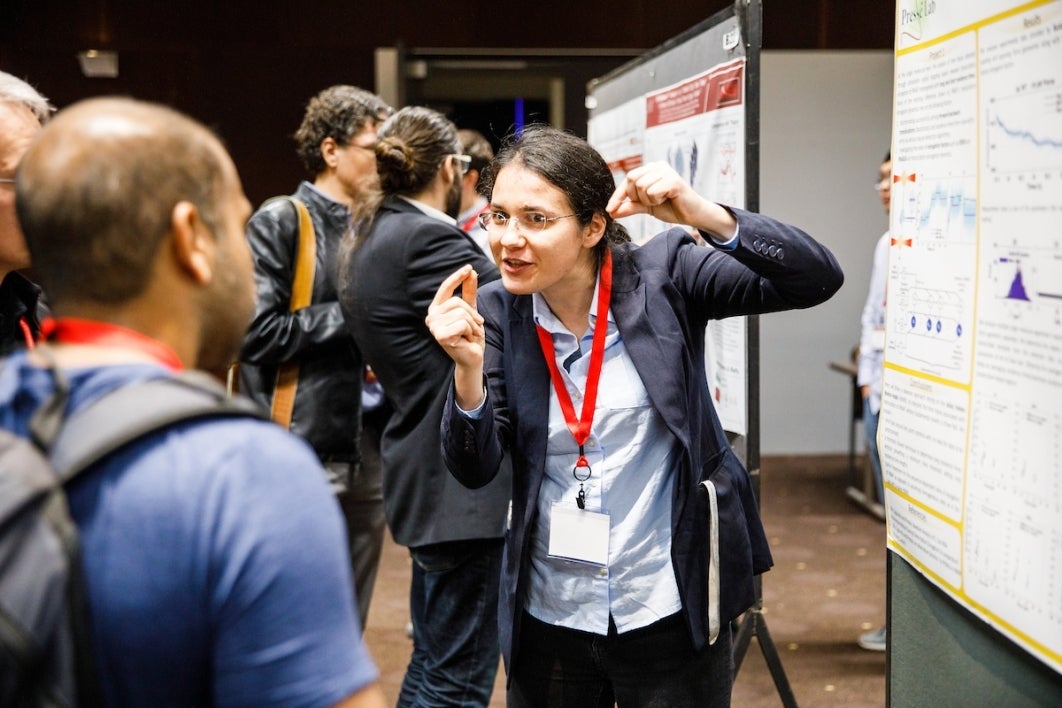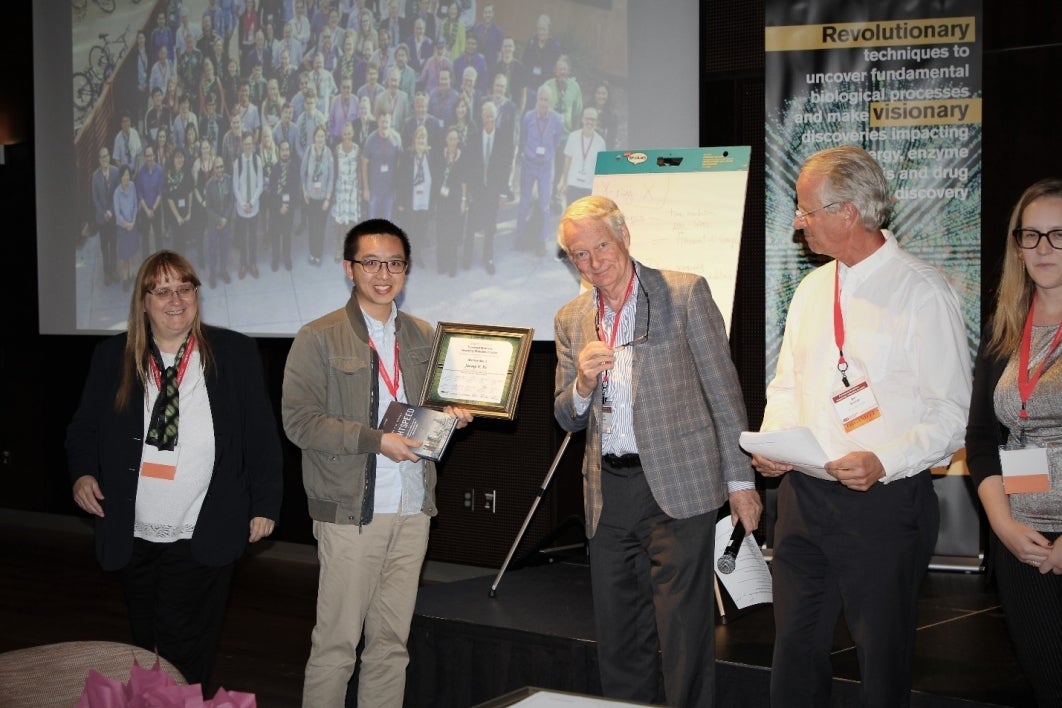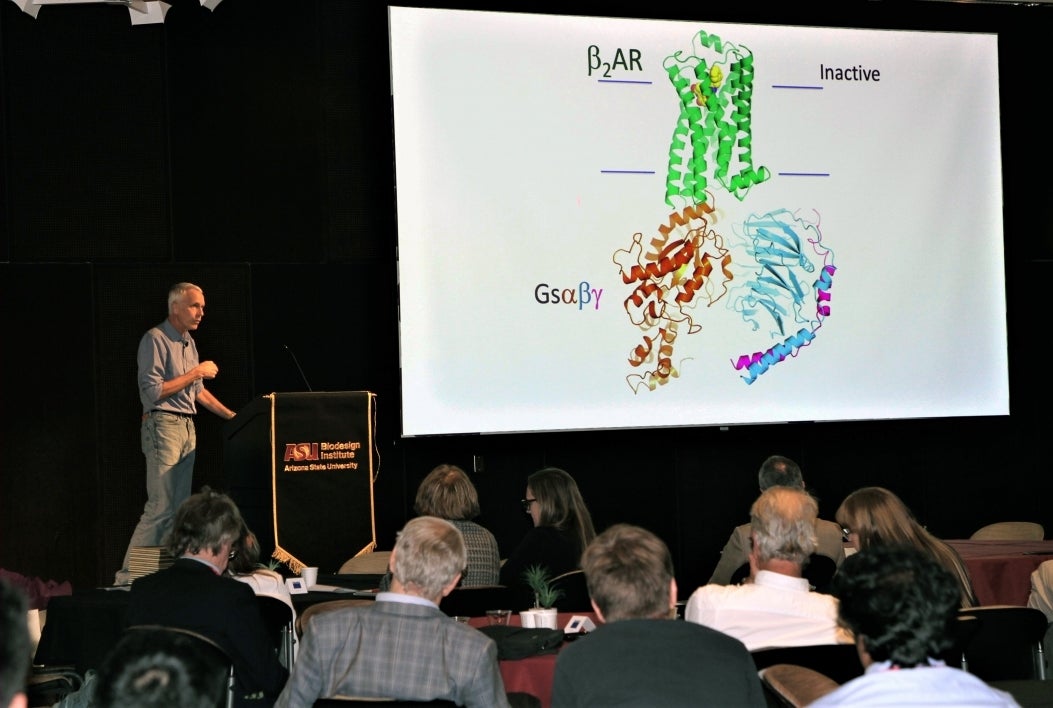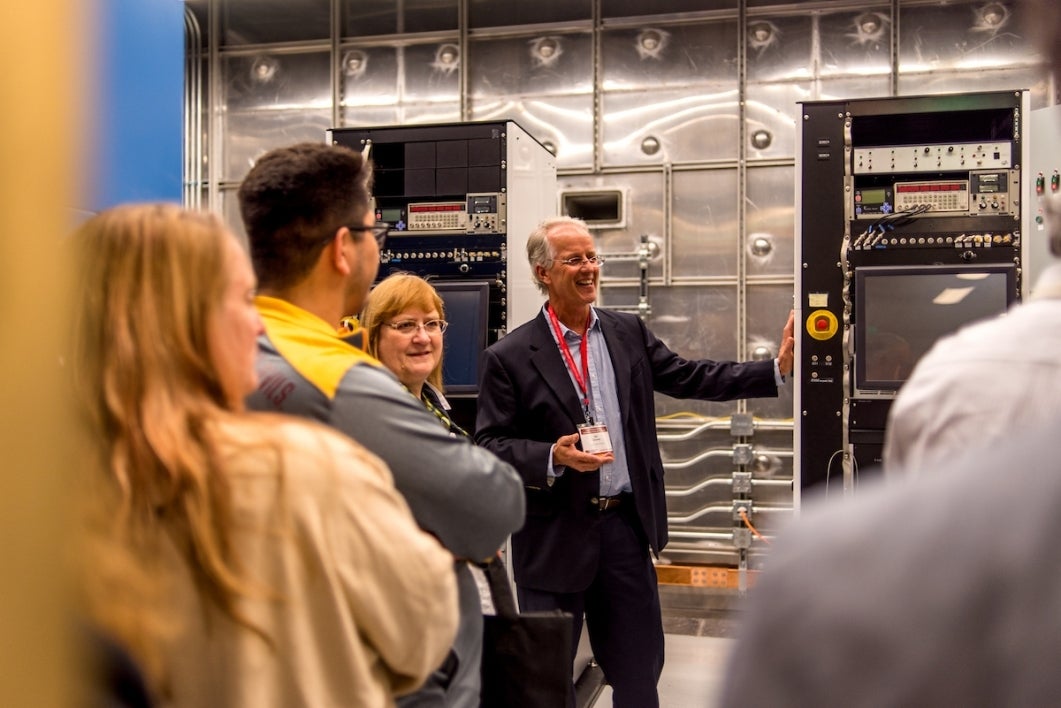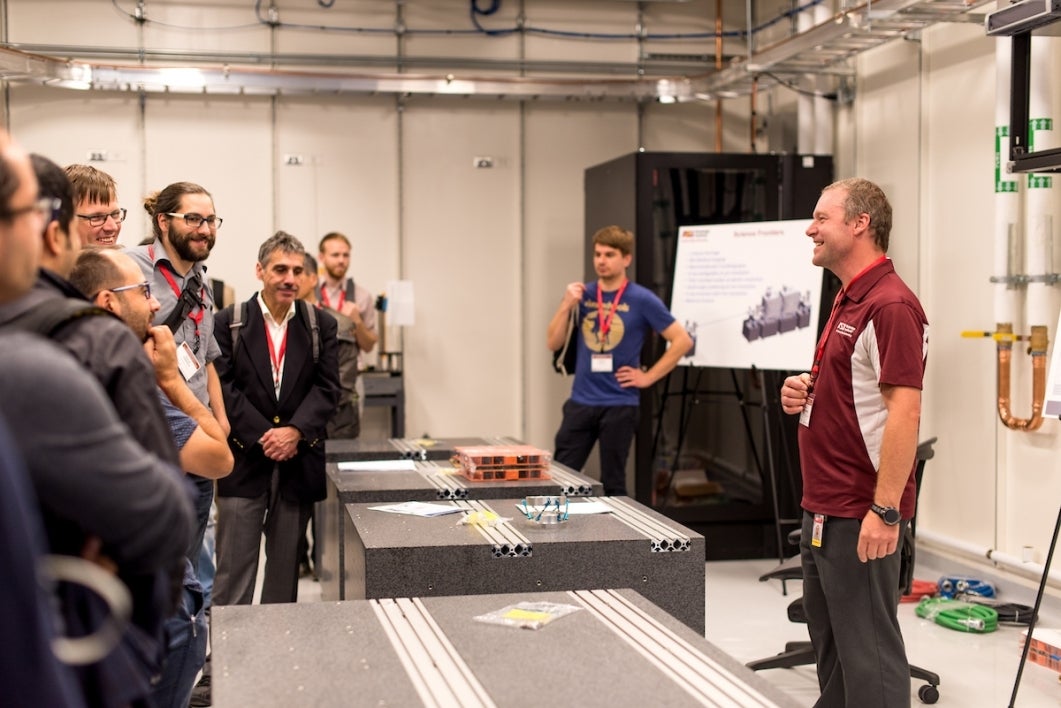World’s top researchers convene at ASU to improve understanding of molecules in action

Nearly 200 researchers from all over the world attended “Functional dynamics — visualizing molecules in action,” co-sponsored by Nature Research and the Biodesign Institute.
Early in November, researchers from around the world gathered at Arizona State University’s Tempe campus for an unusual scientific conference.
“Functional dynamics — visualizing molecules in action” was sponsored by the premier scientific journal Nature, in collaboration with the Biodesign Institute at ASU. The conference highlighted recent advances that have allowed scientists to probe critical aspects of nature occurring at mind-bogglingly tiny dimensions of space and during fleetingly brief flickers of time.
The gathering drew participants from around the world: researchers working in the areas of biology, physics, chemistry and materials science. Methods probing molecular-level dynamics were a central focus. The methods and discoveries discussed will have an impact on areas ranging from the exploration of nature’s design recipes for biomolecules to understanding the subtle behavior of industrial catalysts, to mapping energy flow within molecules to new discoveries in quantum physics.
A more thorough understanding of these enigmatic, atomic-scale processes will help scientists explore how vital proteins carry out tasks essential to life, develop new smart materials, more effectively treat diseases and design better drugs and pioneer new forms of sustainable energy by borrowing from nature’s tool kit.
The conference was made possible by remarkable advances in imaging technologies including spectroscopy, cryo-EM microscopy, X-ray crystallography and computer simulation that have allowed scientists to probe structural and electronic changes with spectacular temporal and spatial resolution.
Director’s notes
The conference kicked off with an introduction from Joshua LaBaer, executive director of the Biodesign Institute and director of the Virginia G. Piper Center for Personalized Diagnostics. LaBaer noted that ASU is the perfect forum for this international event, due to the deeply interdisciplinary ethos of the university, as well as its recent status as a pioneer in next-generation research into the details of molecular motion. Perhaps most notably, ASU is also the future home for what may be the world’s first compact X-ray free electron laser — one of the exciting new technologies driving many advances addressed at the conference.
LaBaer’s remarks were followed by a welcome from Petra Fromme, director of the Biodesign Center for Applied Structural Discovery and co-chair of the conference scientific committee. Fromme provided a brief snapshot of the intellectual surprises in store over the course of the meeting, stressing the importance of participants’ involvement and exchange of ideas. She also expressed excitement that the gathering had drawn so many luminaries from across the world to share their insights.
Magdalena Helmer, senior editor of physical sciences at Nature and event co-chair, welcomed conference guests, paraphrasing novelist Jane Austen: "It is a truth universally acknowledged that a curious scientist, in possession of a burning question, must be in want of a method."
The breadth and diversity of the science presented over the following three days of the conference were indeed testament to the transformative nature of new methods and instruments for the advancement of science.
“Over the last 10 years or so, many different methods used in many different fields have been developed and improved so much that it is now possible to really get up close to some of the fundamental interactions and processes that underpin what goes on in our bodies; that give materials their functionally interesting properties; or that underpin devices and modern technologies,” Helmer said.
She emphasized the importance of celebrating and showcasing these new technologies by featuring talks from outstanding scientists from radically different disciplines. “And, for me as a Nature editor, it is really nice that the conference coincides with Nature's 150th birthday.”
The conference was co-organized by seven Nature journal editorsIn addition to Magdalena Helmer, the following editors from Nature served on the conference planning committee: Gavin Armstrong (Nature Chemistry, U.K.), Allison Doerr (Nature Methods, U.K.), Angela Eggleston (Nature, U.S.), Bishwanath Gaire (Nature Communications, U.S.), Karin Kuehnel (Nature Communications, U.K.), and Andrea Taroni (Nature Physics, U.K.). and noted researchers at ASU, including Fromme; Bill Graves, a professor of physics and mastermind behind ASU’s compact X-ray free electron laser (CXFEL); and John Spence, Richard Snell Professor of Physics at ASU. Fromme, Spence and Graves are all faculty members in the Biodesign Center for Applied Structural Discovery.
A crazy quilt of new science
Much of the conference lectures and discussions centered around experiments with X-ray free electron laser (XFEL) technology, which has revolutionized the study of matter down to atomic scale resolution and over time frames measured in quadrillionths of a second.
The conference was divided into five sessions, each designed to stimulate new ideas and foster collaborations:
- Session 1: Mapping ultrafast light-triggered molecular motion.
- Session 2: Visualizing catalysis in real time.
- Session 3: Energy transfer and excited-state dynamics.
- Session 4: Dynamics of interfaces.
- Session 5: Tracking large-scale molecular dynamics.
In Session 1, a keynote address was presented by Marius Schmidt, one of the pioneering giants in the field of ultrafast investigations into matter. His talk focused on developments in time resolved serial femtosecond crystallography, a groundbreaking method that uses X-ray lasers to strike crystalized biomolecules like proteins. Multiple bursts of X-ray light that is about a billion times the brilliance of conventional synchrotron X-rays strike these crystals generating diffraction patterns that can be reassembled into highly detailed structural images and even movies of atomic-scale dynamic behavior.
In Session 2, mechanisms of photosynthesis, another major area of investigation via new X-ray techniques, were discussed by Junko Yano, a senior researcher at the Lawrence Berkeley National Laboratory. Her talk illuminated the water oxidation reaction occurring in Photosystem II, a critical multisubunit protein complex and the first link in the chain of photosynthesis.
Later, in the same session, another luminary took the stage to discuss how X-ray free electron lasers can be used for macromolecular structural determination under room temperature conditions. Henry Chapman directs the Center for Free Electron Laser Science at the Deutsches Elektronen Synchrotron at the University of Hamburg in Germany. His talk described the exploratory power of modern XFEL technologies operating at femtosecond speeds that allow “diffraction before destruction” of crystallized samples.
The interaction of light and matter is of fundamental interest to the fields of both physics and chemistry. It’s an area of specialty for Scott Sayres, the next speaker, who is a researcher in the Biodesign Center for Applied Structural Discovery. Such light and matter interactions have recently been pushed to higher energies, thanks to new technological advances, revealing new science in the process. By combining three detection methods, Sayres research describes how electron motion influences chemical reactions in response to ultrashort (femtosecond and attosecond) laser pulses to better understand fundamental processes.
Later in the session, Bill Graves discussed the intense activities taking place in the newly designed Biodesign C complex, where ASU’s compact XFEL is under construction. Graves announced $4.7 million in new funding from the National Science Foundation for a thorough design study in order to develop the X-ray lasing version of the light source, the first iteration of which is nearing completion.
Of blue dreams and Nobel laureates
In the evening of Day 2, conference-goers were treated to an after-dinner lecture by Ada Yonath of the Weizmann Institute in Israel concerning eco-friendly antibiotics and the origins of life. An expert on cellular organelles known as ribosomes, Yonath established the first biological crystallography laboratory in Israel. Among her innumerable international awards, she is the 2009 recipient of the Nobel Prize in chemistry for studies of the structure and function of the ribosome, joining Marie Curie, Irène Joliot-Curie and Dorothy Crowfoot Hodgkin as one of only four female Nobel laureates in that field.
A second Nobel laureate in chemistry, Brian Kobilka, also spoke at the conference. Kobilka is a professor and chair of molecular and cellular physiology at the Stanford University School of Medicine. He shares the 2012 Nobel Prize with Robert Lefkowitz, professor of biochemistry and of medicine at Duke University, for their work on G-protein-coupled receptors, a number of proteins that reach through cell walls, play vital roles in health and disease and are primary targets for drug development.
Sneak peek into the Beus Lab and technology of the future
When not immersed in intense rounds of lectures, study groups and poster sessions, conference attendees enjoyed special events, including an evening gala and tour of Biodesign’s compact X-ray free electron laser, currently under construction. The device mimics many of the performance capabilities of the five massive linear accelerators that currently exist worldwide, accomplishing feats of femtosecond X-ray crystallography at a fraction of the cost.
The new CXFEL promises to provide state-of-the-art capabilities in protein characterization, novel techniques for biomedical imaging in the form of phase contrast imaging and the formation of molecular movies of biomolecules at work, helping scientists find new solutions for the treatment of cancer, diabetes, infections and many other chronic diseases. The instrument will also help researchers pioneer new quantum materials and may have applications as diverse as exploration geology and art restoration.
"The conference was fascinating for the breadth of fields that were represented and the many wonderful talks on major advances in techniques and results around the world,” according to Graves. “Our visitors were blown away by Biodesign's new CXFEL labs and the capabilities we are building on campus. Their exposure to ASU's people and facilities has led to new collaborations including plans to spend significant time at ASU to pursue science that is not otherwise possible."
Action, energy and awards
In between an ambitious schedule of 33 talks in three days, conference-goers found lots of opportunities for action and interaction. Roundtable discussions on “hot topics” were lively as the small groups surfaced ideas and solutions to vexing challenges. Researchers from various disciplines learned from one another and cross-pollinated to arrive at new possibilities. According to Graves, several new collaborations formed immediately, with the prediction that there are more to come.
Nearly 80 posters were available for viewing, discussion, inspiration and input. According to Fromme, the engagement and interaction was so intense that it was nearly impossible to lead attendees back to the regular sessions. Some 30 poster presenters were eager to present their research in one-minute flash talks, with a mix of emerging and well-established scientists joining in the fun.
Concluding the formal sessions was an awards ceremony for posters in 10 categories. Awardees were presented with certificates signed by each member of the scientific organizing committee and various gifts, including Nature magazine subscriptions and copies of John Spence’s recently published book, "Lightspeed: The Ghostly Aether and the Race to Measure the Speed of Light."
Poster awardees
Catalysis award for the best poster probing catalysis
Jose M. Martin-Garcia, ASU Biodesign Institute, for “Watching the Inactivation of an Antibiotic by an Enzyme at an X-ray Free Electron Laser.”
Energy award for the best poster probing energy or charge transfer
Christine Lewis, ASU Biodesign Institute, for “Unlocking Efficiency: Dynamic electro-molecular investigations of photosynthetic energy flow.”
Interface award for the best poster exploring dynamics at interfaces
Jong Woo Kim, ASU Biodesign Institute, for “X-ray coherent surface scattering imaging exceeding 3-NM resolution.”
Macromolecule award for the best poster tracking large-scale molecular dynamics
Eduardo E. Romero, University of Central Florida, for “Cascade electric dipole moment and its role on the Amyloid-β(1-42) fibril formation.”
Quantum award for the best poster exploring quantum effects
Jimmy K. Yu, Stanford University Department of Chemistry, for “First principles characterization of the illusive I fluorescent state and the structural evolution of retinal protonated Schiff base in bacteriorhodopsin.”
Innovation award for the best poster on novel technique development
Jie Yang, SLAC National Accelerator, for “Direct visualization of hydrogen bond dynamics in liquid water using MEV ultrafast electron diffraction.”
Creativity award for the best poster presenting creative new ideas
Richard Kirian, ASU Department of Physics, for “Shape transform phasing.”
Sample Challenge award for the best poster addressing challenges in sample preparation and characterization
Rebecca Jernigan, ASU Biodesign, for “New structural insights into the function of the active full length human Tapase1: A novel anticancer therapeutic target."
Data award for best poster tackling data evaluation challenges
Zeliha Kilic, ASU Department of Physics, for “RNA polymerase dynamics and other single molecule continuous time problems.”
Materials award for the best poster on time resolved studies on materials
James Utterback, University of California, Berkeley Department of Chemistry, for “Optical and X-ray scattering of self-assembled nano particles.”
A lovely time was had by all
The event ended with a celebration at a Tempe restaurant where networking continued in full force, with an evening of animated dialogue that those gathered never wanted to end. Excursions on Saturday were optional, with visitors enjoying the great Arizona outdoors with a hike of South Mountain’s Kiwanis Trail led by Justin Flory, assistant research scientist in the Center for Applied Structural Discovery, or a leisurely narrated cruise of Arizona’s flora and fauna on Saguaro Lake’s Desert Belle.
“Perhaps the greatest endorsement we received on the value and impact of the conference was the countless number of people who asked, ‘When can we do this again’?” said Dianne Price of Biodesign Science Communications, who coordinated the event. “The conference was not a one-shot deal, but a great way to begin cultivating a new community of researchers who have a vested interest in advancing science and methods like the CXFEL."
For more information about the conference visit the conference website.
For more information about related research, visit Biodesign Center for Applied Structural Discovery.
Stay informed about the development of the compact X-ray free electron laser.
More Science and technology

ASU professor wins NIH Director’s New Innovator Award for research linking gene function to brain structure
Life experiences alter us in many ways, including how we act and our mental and physical health. What we go through can even…

ASU postdoctoral researcher leads initiative to support graduate student mental health
Olivia Davis had firsthand experience with anxiety and OCD before she entered grad school. Then, during the pandemic and as a…

ASU graduate student researching interplay between family dynamics, ADHD
The symptoms of attention deficit hyperactivity disorder (ADHD) — which include daydreaming, making careless mistakes or taking…
